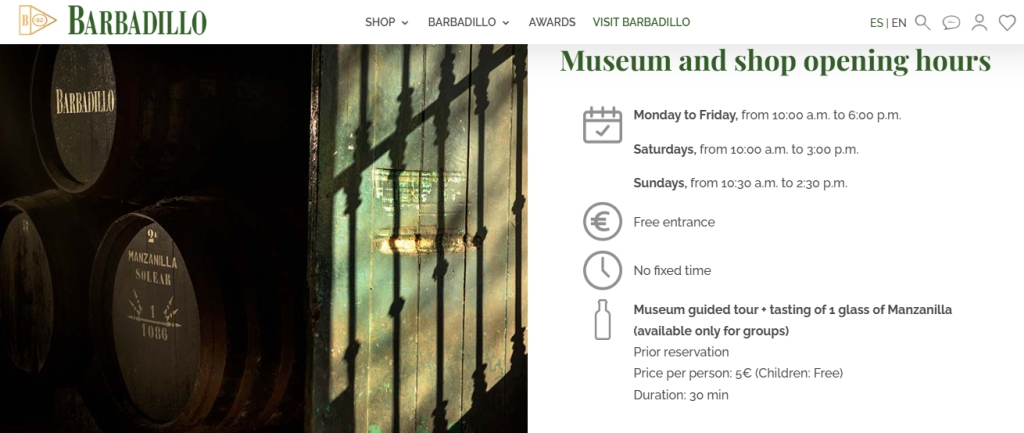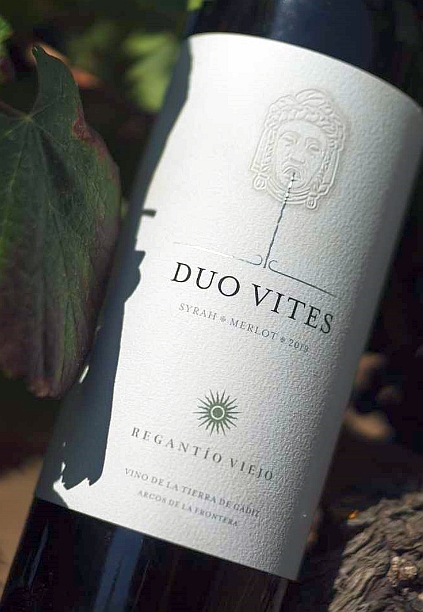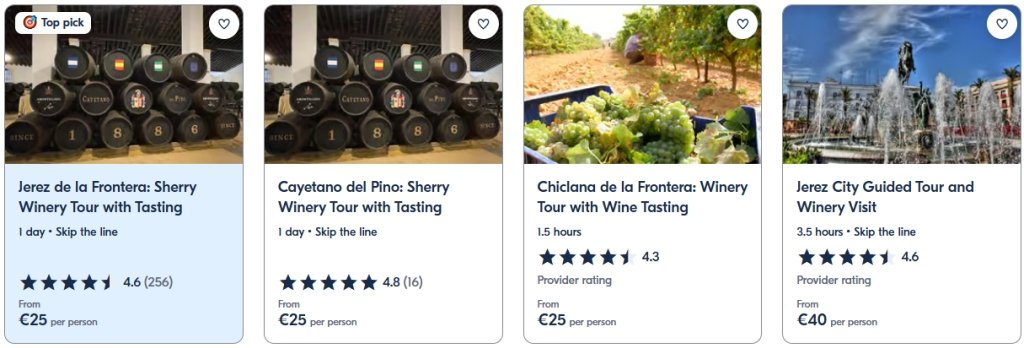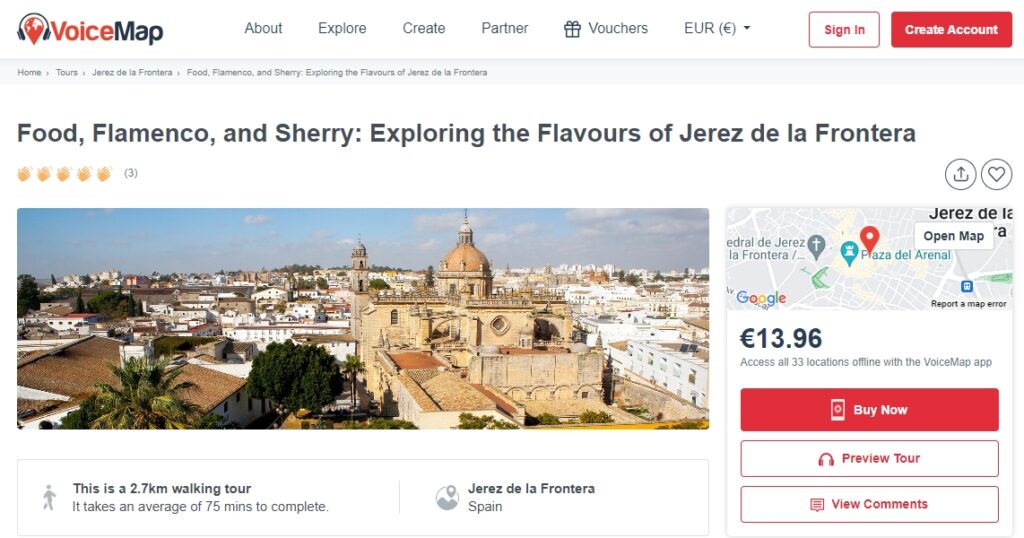The province of Cádiz offers an enchanting experience for wine enthusiasts, with two distinctive wine routes: the Wine and Brandy Route of Jerez and the Sierra de Cádiz Wine Route. While the Jerez route is more widely recognised, the Sierra de Cádiz is equally rich in culture and tradition. This guide delves into these celebrated routes, exploring their landscapes, flavours, and cultural heritage. So, lets start exploring Cádiz’s wine routes.
NOTE: Jerez = Sherry 🙂 The English name was invented to help sales. After all, who would buy a product if they couldn’t pronounce it!

The Wine and Brandy Route of Jerez
The Wine and Brandy Route of Jerez begins in Chiclana de la Frontera, passing through Puerto Real, El Puerto de Santa María, Rota, Chipiona, Sanlúcar de Barrameda, Trebujena and, of course, the iconic Jerez de la Frontera.
The route leads visitors through scenic landscapes, historic towns, and vibrant beaches, each destination offering a distinct aspect of the region’s rich heritage and natural beauty. Here, some of the world’s finest finos, olorosos, manzanillas, vinegars, and brandies are produced, making this area an essential destination for wine lovers.
Wine Tours in the Sherry triangle of Cádiz
Around Cádiz, a variety of winery and wine‑tasting experiences await visitors. Tours range from short vineyard walks and tasting sessions to full‑day excursions exploring historic bodegas. Guests can learn about the production of local wines, including the region’s famous sherry and Manzanilla varieties, while sampling different vintages. Many tours combine wine tastings with local food pairings, scenic vineyard views, and insights into the region’s winemaking traditions, offering both cultural and culinary experiences for wine enthusiasts.
Find wine tasting and winery tours at Get Your Guide.
Find wine tasting, tapas and winery tours over at Viator here.
Sherry, Brandy, and More
The route encompasses the renowned Jerez-Xérès-Sherry, Manzanilla-Sanlúcar de Barrameda, Vinagre de Jerez, and Brandy de Jerez denominations. Over 10,000 hectares of vineyards in the Jerez region cultivate grape varieties like Palomino and Pedro Ximénez, yielding diverse sherries such as fino, oloroso, amontillado, and palo cortado.
Besides sherry, Jerez and Chipiona also produces brandy, while the coastal town of Sanlúcar specialises in manzanilla.
Sweet and fortified wines like pale cream, medium, and cream are also crafted by blending dry wines with sweet varieties.

A Fusion of Wine, Flamenco, and Cuisine
In addition to wine, the region’s cuisine is a highlight. Each town offers its own culinary specialities, from Sanlúcar’s seafood to the local produce of Trebujena and Chipiona.

Festival season is also a fantastic time to sample local fare; notable events include Sanlúcar’s fair in May-June, dedicated to manzanilla, Jerez’s horse fair in May, El Puerto’s wine fair in May, and Trebujena’s mosto fair in August. (Mosto in its grape juice form is a popular soft drink. In Jerez it is usually an alcoholic drink and contains around 11ᴼ-11.5ᴼ of alcohol. It is not made into Sherry but simply left as a table wine and usually sold with minimal filtration.)
Centuries of Tradition in Winemaking
The wines of the sherry triangle follow a production method refined over centuries. Jerez wines are aged in American oak casks, while Jerez vinegar is highly prized for its culinary uses. In Jerez, the complex solera and criadera systems are also used in brandy production. Visitors can immerse themselves in the rich winemaking tradition that permeates the town, which is renowned for flamenco, horses, and historic monuments, making it a must-see destination.
Iconic Bodegas Along the Route
In El Puerto de Santa María, Bodegas Osborne is one of the standout wineries, offering visitors a glimpse into the region’s winemaking legacy.
Sanlúcar de Barrameda, across from Doñana National Park, is home to prominent bodegas like Barbadillo and La Guita. The Barbadillo Manzanilla Museum, located in a historic 19th-century building, provides insight into the evolution of manzanilla. Visitors can enjoy wine tastings, tour production areas, and even watch an audiovisual presentation on the region’s winemaking history.

The North-West Coast and Coastal Wines
Chipiona, Rota, and El Puerto de Santa María The North-West Coast of Cádiz includes the towns of Chipiona and Rota, both renowned for unique wines and cultural treasures. Chipiona is famous for its muscatel wine and is also home to Spain’s tallest lighthouse.
Rota, meanwhile, produces tintilla, a rare wine made from ripe grapes, often referred to as a true gem among local wines. El Puerto de Santa María features renowned bodegas, including Osborne, Terry, and Luis Caballero, where visitors can enjoy tastings and learn about the local wine culture.
The Sierra de Cádiz Wine Route – Exploring the Sierra’s Vineyards and White Villages
The Sierra de Cádiz Wine Route encompasses the mountainous municipalities of Arcos de la Frontera and Prado del Rey. Here, wines are produced under the Tierra de Cádiz designation, with local bodegas like Regantío Viejo, Páez Morilla, Taberner, and Bodegas Rivero offering a diverse selection of reds and whites. Arcos de la Frontera, perched on a stunning cliffside, is part of the Route of the White Villages, which comprises of picturesque towns such as Bornos, Espera, and Grazalema.

A Unique Rural Experience Arcos is celebrated for its breathtaking views and rich history. The Plaza del Cabildo offers visitors an iconic lookout known as the “window” to this stunning town. Surrounded by orchards, olive groves, and a local reservoir, Arcos offers a blend of natural beauty and winemaking tradition.
Both Regantío Viejo in Arcos and Rivero Wineries in Prado del Rey provide tours giving visitors an immersive experience in the area’s winemaking and culinary traditions.

Exploring the wine routes of Cádiz offers an enriching journey through the history, culture, and flavours of Andalusia. From the vibrant Wine and Brandy Route of Jerez to the picturesque Sierra de Cádiz Wine Route, each stop promises a unique experience that captures the spirit of the region. Whether you’re drawn by the wine, the scenic landscapes, or the lively festivals, Cádiz has something for every traveller.
More information about wine tours in and around Cádiz
Are you visiting Ronda? See our wine tours information page here.
Check out our food article about what to eat in Cádiz here.
See the route of the white villages (Pueblos Blancos) here.
Food, Flamenco, and Sherry: Exploring the Flavours of Jerez de la Frontera
Check out the VoiceMap audio guided tour of Jerez de la Frontera. Conveniently, the last stop on the tour is the famous Tio Pepe winery. Ideal for a tasting! 🙂
At the heart of Spain’s vibrant Andalusia region is Jerez de la Frontera, where there’s a treasure trove of culture, gastronomy, and heritage around every corner. On this walking audio tour around the sherry capital of the world, you’ll stimulate the senses as you take in the old town’s main highlights.
Exploring Cádiz Wine Routes: Your Questions Answered
The Wine and Brandy Route of Jerez passes through Chiclana de la Frontera, Puerto Real, El Puerto de Santa María, Rota, Chipiona, Sanlúcar de Barrameda, Trebujena, and Jerez de la Frontera. Each town offers unique wines, local cuisine, and cultural experiences, from historic bodegas to scenic coastal views. For full tour details, see the main article.
Visitors can sample a variety of wines including fino, oloroso, amontillado, palo cortado, and manzanilla. Brandy de Jerez is also a highlight, often aged using traditional solera methods. Some wineries blend dry wines with sweet varieties, producing pale cream, medium, and cream sherries.
Yes, Cádiz offers everything from short vineyard walks to full-day winery excursions. Tours often include tastings, food pairings, and behind-the-scenes insights into winemaking. Notable options include Bodegas Osborne in El Puerto de Santa María and Barbadillo in Sanlúcar de Barrameda.
The Sierra de Cádiz Wine Route combines mountainous landscapes with white villages like Arcos de la Frontera, Prado del Rey, and Bornos. Local bodegas produce reds and whites under the Tierra de Cádiz designation. Visitors enjoy immersive experiences in rural winemaking, orchards, and historic viewpoints.
Festival season runs from May to August. Highlights include Jerez’s horse fair, Sanlúcar’s manzanilla fair, El Puerto’s wine fair, and Trebujena’s mosto fair. These events pair wine tastings with local food, flamenco performances, and lively town celebrations.
Absolutely. Many tours combine vineyard visits with seafood, tapas, and regional dishes. Coastal towns like Sanlúcar and Chipiona offer fresh seafood paella, while inland villages provide traditional Andalusian cuisine. Scenic viewpoints, historic streets, and museums enrich the experience further.
I’ve been living in this lovely area of Western Andalucia for the last 20 years or so and dedicate most of my time to the running of English language tourist information websites for the towns of Cádiz, Ronda, Grazalema, the famous or infamous Caminito del Rey, and also Wildside Holidays, which promotes sustainable and eco-friendly businesses running wildlife and walking holidays in Spain. My articles contain affiliate links that will help you reserve a hotel, bus, train or activity in the area. You don’t pay more, but by using them you do support this website. Thankyou!

